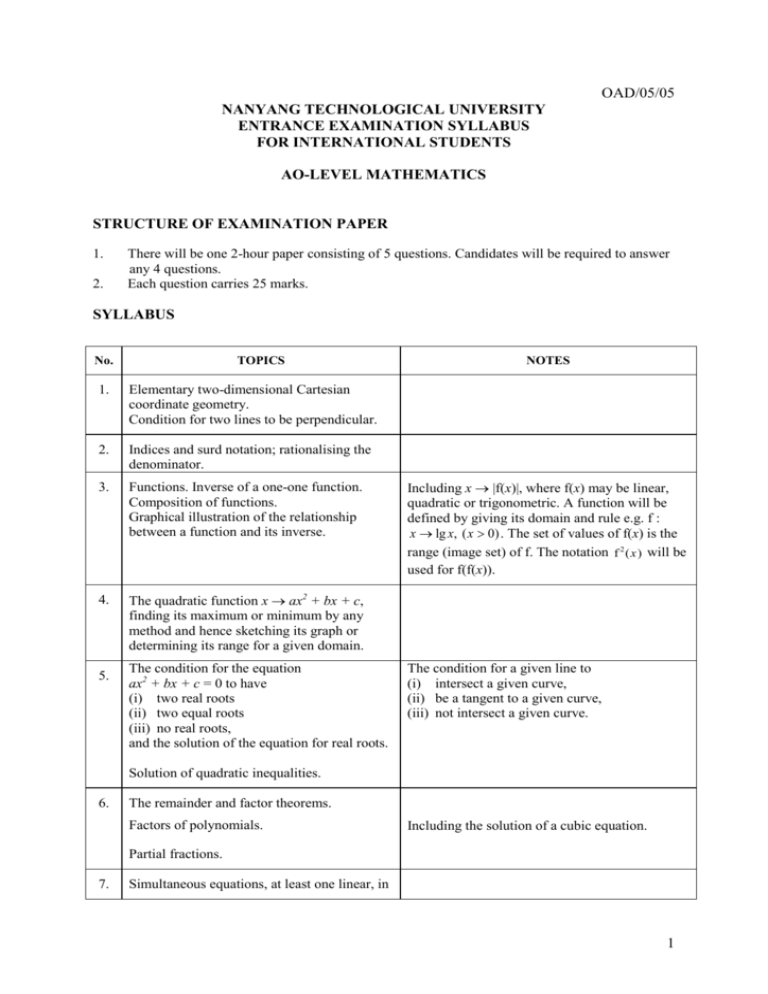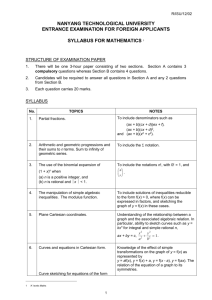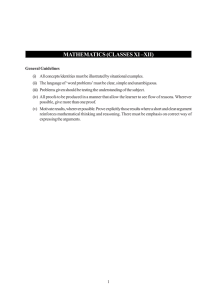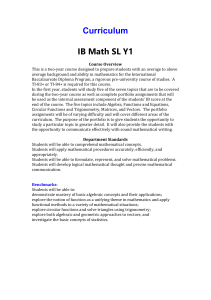11 - Nanyang Technological University
advertisement

OAD/05/05 NANYANG TECHNOLOGICAL UNIVERSITY ENTRANCE EXAMINATION SYLLABUS FOR INTERNATIONAL STUDENTS AO-LEVEL MATHEMATICS STRUCTURE OF EXAMINATION PAPER 1. 2. There will be one 2-hour paper consisting of 5 questions. Candidates will be required to answer any 4 questions. Each question carries 25 marks. SYLLABUS No. TOPICS 1. Elementary two-dimensional Cartesian coordinate geometry. Condition for two lines to be perpendicular. 2. Indices and surd notation; rationalising the denominator. 3. Functions. Inverse of a one-one function. Composition of functions. Graphical illustration of the relationship between a function and its inverse. 4. The quadratic function x ax2 + bx + c, finding its maximum or minimum by any method and hence sketching its graph or determining its range for a given domain. 5. The condition for the equation ax2 + bx + c = 0 to have (i) two real roots (ii) two equal roots (iii) no real roots, and the solution of the equation for real roots. NOTES Including x |f(x)|, where f(x) may be linear, quadratic or trigonometric. A function will be defined by giving its domain and rule e.g. f : x lg x, ( x 0) . The set of values of f(x) is the range (image set) of f. The notation f 2 ( x ) will be used for f(f(x)). The condition for a given line to (i) intersect a given curve, (ii) be a tangent to a given curve, (iii) not intersect a given curve. Solution of quadratic inequalities. 6. The remainder and factor theorems. Factors of polynomials. Including the solution of a cubic equation. Partial fractions. 7. Simultaneous equations, at least one linear, in 1 No. TOPICS NOTES two unknowns. 8. Arithmetic and geometric progressions and their sums to n terms. 9. Determination of unknown constants in a relationship by plotting an appropriate straight line graph. 10. Binomial expansion of (a b) n for positive integral n and its use for simple approximations. 11. Simple properties and graphs of the logarithmic and exponential functions. Including ln x and ex. Their series expansions are Laws of logarithms. not required. Change of base. Questions on the greatest term and on properties of the coefficients will not be asked. Solution of ax = b. 12. Circular measure: arc length, area of a sector of a circle. 13. The six trigonometric functions of angles of any magnitude. The graphs of sine, cosine and tangent. Knowledge of the relationships sin A tan A , cos A cos A cot A , sin A sin2A + cos2A = 1, sec2A = 1 + tan2A, cosec2A = 1 + cot2A. Solution of simple trigonometric equations involving any of the six trigonometric functions and the above relationships between them. Simple identities. 14. Addition Formulae, sin(A ± B), cos(A ± B), tan(A ± B), and application to multiple angles. Expression of a cos b sin as R cos( ) or R sin( ) and solution of a cos b sin c . 15. The general solution of trigonometric equations will not be required. Vectors in two dimensions: General solution excluded. Questions may be set using any vector notation including the unit vectors i and j. magnitude of a vector, addition and subtraction of vectors, multiplication by scalars, scalar (dot) product. 2 No. TOPICS NOTES Position vectors. Unit vectors. 16. Derivatives of standard functions. Derivative of a composite function. Differentiation of sum, product and quotient of functions and of simple functions defined parametrically. Both f(x) and dy will be used. dx The derivatives of xn (for any rational n), sin x, cos x, tan x, ex, ln x and composite functions of these. Applications of differentiation to gradients, tangents and normals, stationary points, velocity and acceleration, connected rates of change, small increments and approximations; practical problems involving maxima and minima. 17. Integration as the reverse process of differentiation. Elementary properties of integrals. Simple integration techniques. The integrals of (ax + b)n (including n = – 1), eax + b, sin(ax + b), cos(ax + b). Integration by simple substitution is included. Definite integrals. Applications of integration to plane areas; displacement, velocity and acceleration. 18 Representation of a curve by means of a pair of parametric equations. Single parameter only. Conversion from parametric to Cartesian coordinates and from Cartesian to parametric coordinates. Equations of tangent and normal. 19 Elementary permutations and combinations. Sept 2005 3











